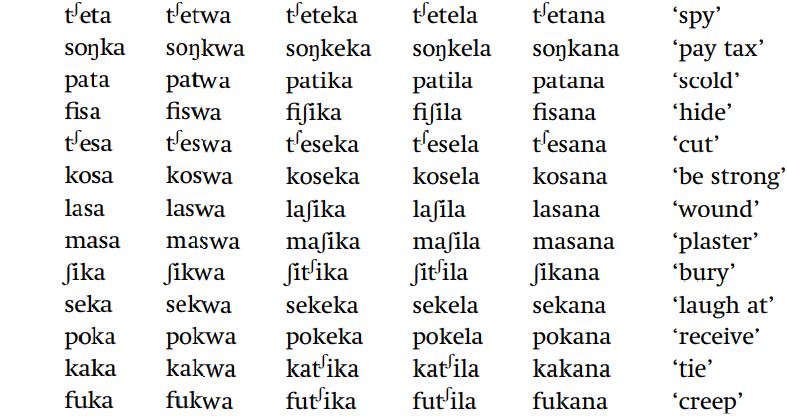
Lamba: harmony and palatalization
 المؤلف:
David Odden
المؤلف:
David Odden
 المصدر:
Introducing Phonology
المصدر:
Introducing Phonology
 الجزء والصفحة:
128-5
الجزء والصفحة:
128-5
 29-3-2022
29-3-2022
 2508
2508
Lamba: harmony and palatalization
The following data illustrate the interaction between a rule of vowel harmony and a palatalization rule in the language Lamba (Zambia):


In order to see what these data show, we must first understand the morphological structure of these words, a step which leads us to realize that the pronunciation of certain morphemes changes, depending on their phonetic context. Verbs in Lamba are composed of a root of the form CV(C)C, an optional derivational affix marking passive, neuter, applied or reciprocal, and a word-final suffix -a which marks the form as being a verb. The underlying forms of the passive and reciprocal suffixes are clearly -w- and -an-, since they exhibit no phonetic variations. The neuter and applied suffixes appear phonetically as -ik- and -ek-, -il- and -el-. The choice of vowel in the suffix is determined by the vowel which precedes the suffix: if the verb root contains the vowel i, u, or a the suffix has the vowel i, and if the root contains the vowel e or o the suffix has the vowel e. The group of vowels i, u, a is not a natural phonetic class, so it is implausible that the suffixes are underlyingly -el- and -ek- with -il- and -ik- being derived by a rule. The class of vowels e, o is the phonetic class of mid vowels; it is thus evident that this language has a vowel harmony rule which assimilates underlying high vowels (in the suffixes /il/ and /ik/) to mid vowels when they are preceded by mid vowels.

There is an alternation in the realization of certain root-final consonants. As shown in examples such as kaka ~ kat ʃ ika and lasa ~ laʃika, the velar consonants and the alveolar continuant s become alveopalatals when they are followed by the vowel i, by processes of palatalization. It is difficult to express a change of /k/ and /s/ to alveopalatal by one rule without including /t/ – which does not change, see [patika] – so two separate rules are needed.


The interaction between these processes is seen in words which could in principle undergo both of these processes: roots with the vowel e or o, and the final consonant k or s. The example sekeka ‘laugh at’ from /sek-ik-a/ shows how these processes interact. Suppose, first, that palatalization were to apply before vowel harmony. Since the underlying representation has the sequence /ki/ which is required by palatalization, that rule would apply. Subsequently, vowel harmony would assimilate /i/ to [e] after /e/, giving the wrong surface result. This is illustrated below in a derivation which spells out the results of applying first palatalization, then height harmony.

Thus, applying the rules in this order gives the wrong results: this order cannot be correct.
On the other hand, if we apply the processes in the other order, with height harmony applying before palatalization, then the correct form is generated.

 الاكثر قراءة في Phonology
الاكثر قراءة في Phonology
 اخر الاخبار
اخر الاخبار
اخبار العتبة العباسية المقدسة


